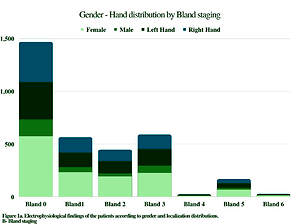Current issue
Archive
Manuscripts accepted
About the Journal
Editorial office
Editorial board
Section Editors
Abstracting and indexing
Subscription
Contact
Ethical standards and procedures
Most read articles
Instructions for authors
Article Processing Charge (APC)
Regulations of paying article processing charge (APC)
NEUROLOGY / CLINICAL RESEARCH
Electrophysiological evaluation of carpal tunnel syndrome
1
Department of Neurology, Faculty of Medicine, Recep Tayyip Erdoğan University, Rize, Turkey
2
Department of Neurology, Faculty of Medicine, Karadeniz Technical University, Trabzon, Turkey
Submission date: 2021-12-19
Final revision date: 2022-08-25
Acceptance date: 2022-09-02
Online publication date: 2022-09-09
Corresponding author
KEYWORDS
TOPICS
ABSTRACT
Introduction:
Carpal tunnel syndrome (CTS) is the most common entrapment neuropathy in society. Based on the data obtained from basic conventional CTS studies, patients can be staged, and the changes in CTS severity can be followed according to the electrophysiological parameters derived from the data. This study aimed to assess the electrophysiological findings of CTS patients using the Bland and Padua grading systems and median terminal latency index (mTLI) and to evaluate the findings that may indicate the transition to the advanced stage.
Material and methods:
The study included 822 patients. After electrophysiological examination, both hands of the patients were staged according to the grading systems proposed by Padua and Bland. Additionally, mTLI was calculated for each hand.
Results:
With the increase in stages, a significant decrease was found in mTLI, median sensory nerve conduction velocity (mSNCV), median sensory amplitude (mSA), median motor nerve conduction velocity (mMNCV), and median motor amplitude (mMA), whereas a significant increase was observed in median sensory distal latency (mSDL) and median motor distal latency (mMDL) (p < 0.001) The parameter with the highest sensitivity regarding the indication of transition between stages was mSNCV; the sensitivity increased with the progression of stage, and a cut-off value of 40.5 m/s showed a sensitivity of 94.2% and a specificity of 90% regarding the indication of transition to the advanced stage.
Conclusions:
Our results showed that with a cut-off value of 40.5 m/s, mSNCV is an accurate, sensitive and specific parameter regarding the indication of transition to the advanced stage.
Carpal tunnel syndrome (CTS) is the most common entrapment neuropathy in society. Based on the data obtained from basic conventional CTS studies, patients can be staged, and the changes in CTS severity can be followed according to the electrophysiological parameters derived from the data. This study aimed to assess the electrophysiological findings of CTS patients using the Bland and Padua grading systems and median terminal latency index (mTLI) and to evaluate the findings that may indicate the transition to the advanced stage.
Material and methods:
The study included 822 patients. After electrophysiological examination, both hands of the patients were staged according to the grading systems proposed by Padua and Bland. Additionally, mTLI was calculated for each hand.
Results:
With the increase in stages, a significant decrease was found in mTLI, median sensory nerve conduction velocity (mSNCV), median sensory amplitude (mSA), median motor nerve conduction velocity (mMNCV), and median motor amplitude (mMA), whereas a significant increase was observed in median sensory distal latency (mSDL) and median motor distal latency (mMDL) (p < 0.001) The parameter with the highest sensitivity regarding the indication of transition between stages was mSNCV; the sensitivity increased with the progression of stage, and a cut-off value of 40.5 m/s showed a sensitivity of 94.2% and a specificity of 90% regarding the indication of transition to the advanced stage.
Conclusions:
Our results showed that with a cut-off value of 40.5 m/s, mSNCV is an accurate, sensitive and specific parameter regarding the indication of transition to the advanced stage.
We process personal data collected when visiting the website. The function of obtaining information about users and their behavior is carried out by voluntarily entered information in forms and saving cookies in end devices. Data, including cookies, are used to provide services, improve the user experience and to analyze the traffic in accordance with the Privacy policy. Data are also collected and processed by Google Analytics tool (more).
You can change cookies settings in your browser. Restricted use of cookies in the browser configuration may affect some functionalities of the website.
You can change cookies settings in your browser. Restricted use of cookies in the browser configuration may affect some functionalities of the website.



